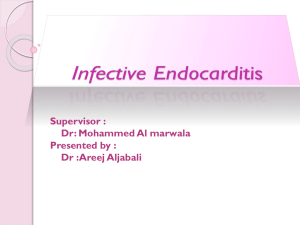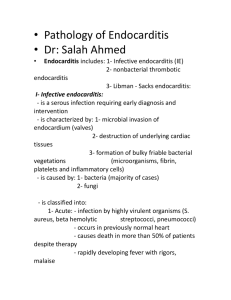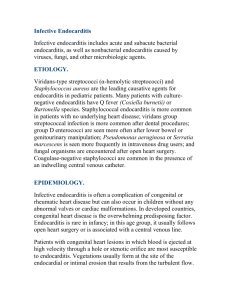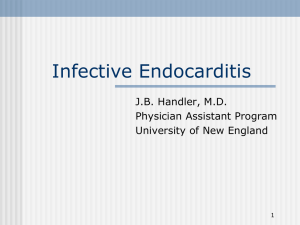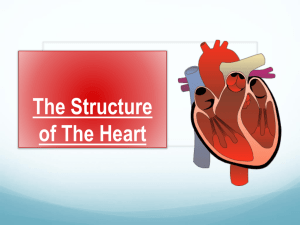Triology of fallot presenting with isolated pulmonary valve infective
advertisement
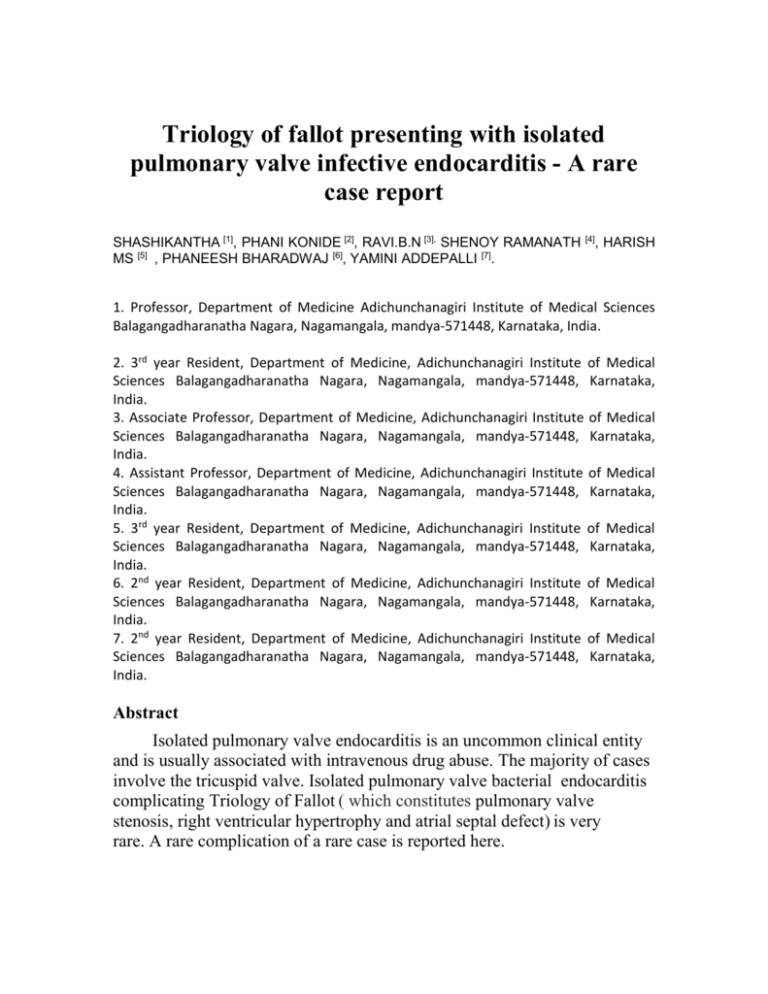
Triology of fallot presenting with isolated pulmonary valve infective endocarditis - A rare case report SHASHIKANTHA [1], PHANI KONIDE [2], RAVI.B.N [3], SHENOY RAMANATH MS [5] , PHANEESH BHARADWAJ [6], YAMINI ADDEPALLI [7]. [4] , HARISH 1. Professor, Department of Medicine Adichunchanagiri Institute of Medical Sciences Balagangadharanatha Nagara, Nagamangala, mandya-571448, Karnataka, India. 2. 3rd year Resident, Department of Medicine, Adichunchanagiri Institute of Medical Sciences Balagangadharanatha Nagara, Nagamangala, mandya-571448, Karnataka, India. 3. Associate Professor, Department of Medicine, Adichunchanagiri Institute of Medical Sciences Balagangadharanatha Nagara, Nagamangala, mandya-571448, Karnataka, India. 4. Assistant Professor, Department of Medicine, Adichunchanagiri Institute of Medical Sciences Balagangadharanatha Nagara, Nagamangala, mandya-571448, Karnataka, India. 5. 3rd year Resident, Department of Medicine, Adichunchanagiri Institute of Medical Sciences Balagangadharanatha Nagara, Nagamangala, mandya-571448, Karnataka, India. 6. 2nd year Resident, Department of Medicine, Adichunchanagiri Institute of Medical Sciences Balagangadharanatha Nagara, Nagamangala, mandya-571448, Karnataka, India. 7. 2nd year Resident, Department of Medicine, Adichunchanagiri Institute of Medical Sciences Balagangadharanatha Nagara, Nagamangala, mandya-571448, Karnataka, India. Abstract Isolated pulmonary valve endocarditis is an uncommon clinical entity and is usually associated with intravenous drug abuse. The majority of cases involve the tricuspid valve. Isolated pulmonary valve bacterial endocarditis complicating Triology of Fallot ( which constitutes pulmonary valve stenosis, right ventricular hypertrophy and atrial septal defect) is very rare. A rare complication of a rare case is reported here. Key words Isolated pulmonary valve, Infective endocarditis, Triology of Fallot. Introduction Isolated pulmonary valve endocarditis is rare, affecting less than 1.5–2% of patients suffering from infective endocarditis.[1] Review of previously published data showed fewer than 90 cases of isolated pulmonary valve endocarditis.[2] Risk factors include intravenous drug abuse, sepsis, central venous catheter and congenital heart diseases. A case of triology of fallot with isolated pulmonary valve endocarditis is presented here. Case report A 63 year old non diabetic and non hypertensive male patient presented with the history of high grade fever from one day associated with chills and rigors .On examination patient was conscious oriented had blood pressure of 90/60 mm Hg, with pulse 76 bpm and regular, on examination there was raised jvp ,bilateral pedal edema and grade 3 systolic murmur best heard in pulmonary area . Investigations revealed ECG suggestive of right ventricular hypertrophy, chest x ray was showing Cardiomegaly with right ventricular hypertrophy and pulmonary artery hypertension (figure 1). Echocardiography showed ostium secundum ASD and L->R shunt ,severe pulmonary valvular stenosis with vegetations attached to pulmonary valve ,right ventricular hypertrophy ,reduced RV function and normal LV function (figure2,3and 4) .Blood investigations showed neutrophilic leukocytosis and no growth after blood culture. patient improved symptomatically with antibiotic therapy within two weeks of admission Figure 1 Figure 3 Figure 2 Figure 4 Discussion The incidence of right-sided infective endocarditis ranges from 5 to 10% in different series [3,4]. The majority of cases involve the tricuspid valve. Isolated pulmonary valve endocarditis is rare. It is assumed that its rarity is due to the low pressure gradients within the right heart, the low prevalence of congenital malformations, the lower oxygen content of venous blood, and the differences in the covering and vascularization of the right heart endothelium[5]. Most cases of pulmonary valve endocarditis in children are secondary to the presence of a congenitally abnormal pulmonary valve and in adults secondary to intravenous drug abuse. Isolated pulmonary valve endocarditis has also been identified in patients undergoing chronic hemodialysis and orthotopic liver transplantation [6,7]. A significant number of patients present with primarily pulmonary symptoms such as pleuritic chest pain, cough, and dyspnea. When peripheral embolic or neurologic features occur, either left sided endocarditis or paradoxical embolism should be considered. A conservative approach is recommended for the majority of patients with infective endocarditis affecting the tricuspid or pulmonary valve [8]. In our case, the patient responded to antibiotics and became asymptomatic within two weeks of initial admission. A review of the published data indicated that the role of surgery in isolated pulmonic valve endocarditis is unclear. Recurrent pulmonary emboli are not an indication for surgery, which is only needed if fever persists despite 3 weeks of appropriate antibiotic treatment in the absence of a pulmonary abscess [9]. Surgical options include debridement of the infected area, vegetation excision with either valve preservation or valve repair or valve replacement. Preservation of the native pulmonary valve is recommended whenever possible, and use of a homograft or xenograft is preferred if replacement is unavoidable. References [1] Cassling RS, Rogler WC, McManus BM. Isolated pulmonic valve infective endocarditis: a diagnostically elusive entity. Am Heart J 1985;109:558– 67. [2] Katsufumi N, Osamu N, Dean SN. Pulmonary valve endocarditis caused by rightventricular outflow obstruction in association with sinus of valsalva aneurysm:a case report. J Cardiothorac Surg 2008;3:46. [3] Delahaye F, Goulet V, Lacassin F, Ecochard R, Suty-Selton C, Hoen B, Etienne J,Brianc¸ on S, Leport C. Characteristics of infective endocarditis in France in 1991:A 1-year survey. Eur Heart J 1995;16(3):394–401. [4] Van der Meer JTM, Thompson J, Valkenburg HA, Michel MF. Epidemiology ofbacterial endocarditis in the Netherlands. Patient characteristics. Arch InternMed 1992;152:1863–8. [5] Ramadan FB, Beanlands DS, Burwash IG. Isolated pulmonic valve endocardi-tis in healthy hearts: a case report and review of the literature. Can J Cardiol2000;16:1282–8. [6] Kamaraju S, Nelson K, Williams DN, Ayenew W, Modi KS. Staphylococcus lug-dunensis pulmonary valve endocarditis in a patient on chronic hemodialysis. AmJ Nephrol 1999;19:605–8. [7] Hearn CJ, Smedira NG. Pulmonic valve endocarditis after orthotopic liver trans-plantation. Liver Transpl Surg 1999;5:456–67. [8] The Endocarditis Working Group of the International Society of Chemotherapy,Petterson G, Carbon C. Recommendations for the surgical treatment of endo-carditis. Clin Microbiol Infect 1998;4(Suppl. 3):S34–46. [9] Moon MR, Stinson EB, Miller DC. Surgical treatment of endocarditis. Prog Car-diovasc Dis 1997;40:239–64.

